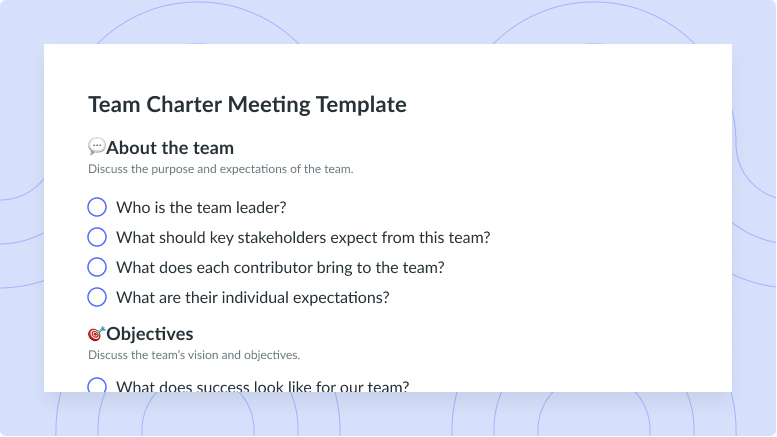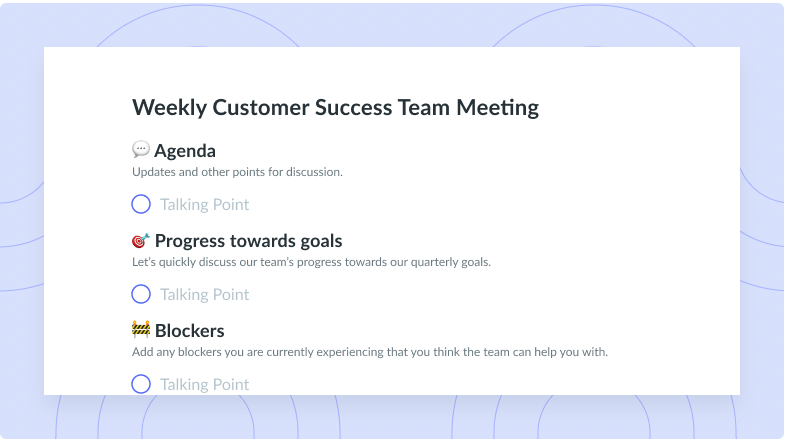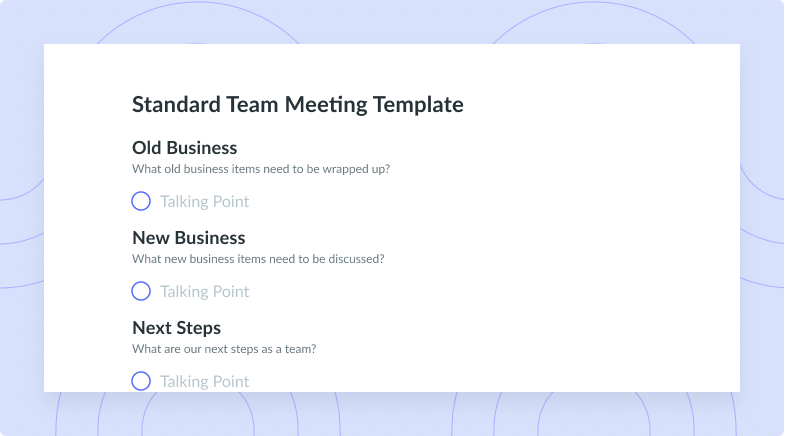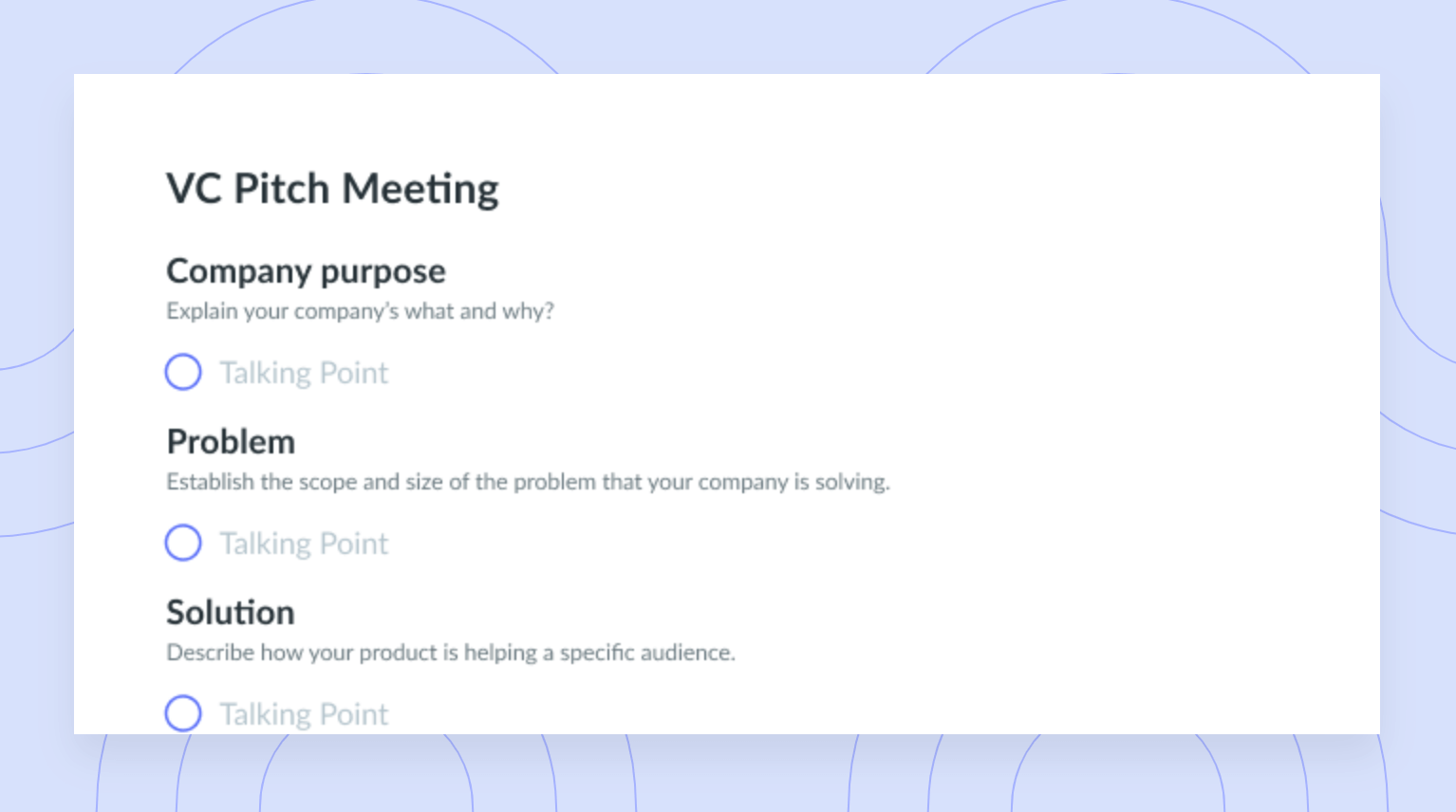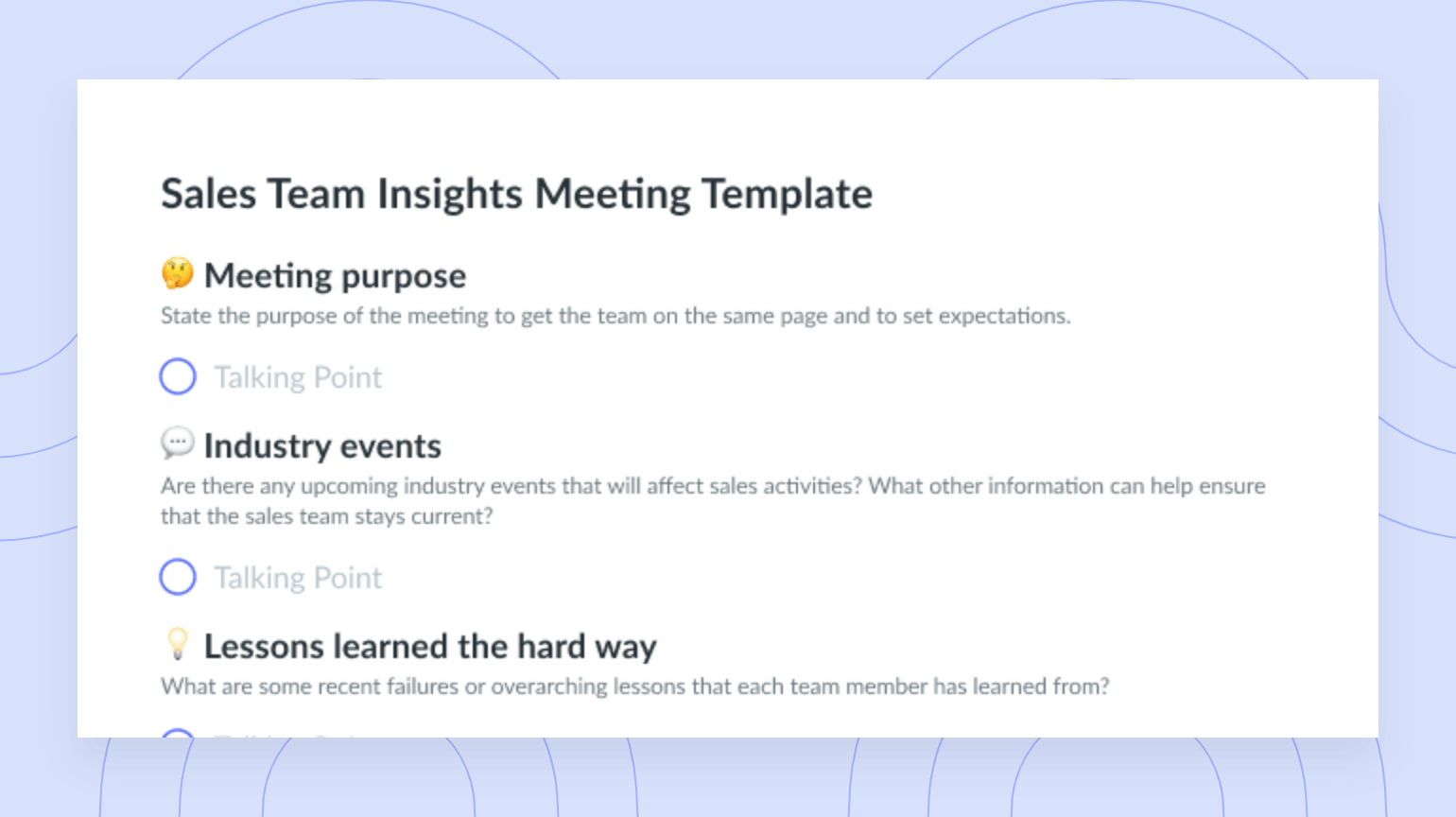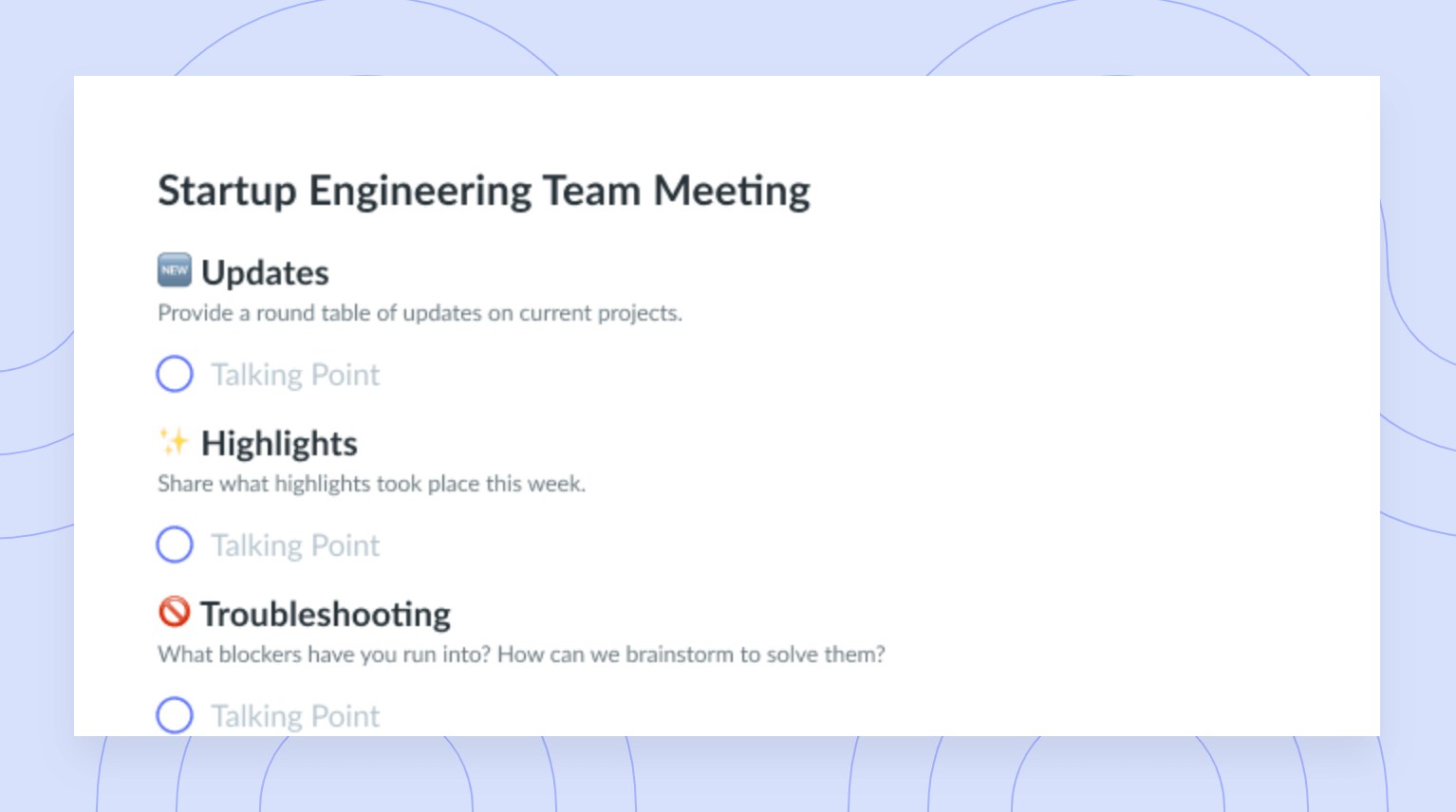9 Types of Manager Meetings Every Team Needs
Here are 9 types of meetings that are worth your team's time and best practices to keep everyone focused, productive, and accountable.
As a manager, you oversee various meetings crucial for team cohesion, project advancement, and decision-making. However, many leaders struggle with efficient meeting management. In this guide, we’ll explore nine essential manager meetings to optimize your team’s time and productivity while fostering accountability.
- 9 types of meetings and how to run them effectively
- 7 tips to make the best use of your meeting time
9 types of meetings and how to run them effectively
- Onboarding meetings
- Weekly team meetings
- One-on-one meetings
- Decision-making meetings
- Problem-solving meetings
- Brainstorming meetings
- Project kickoff meetings
- Feedback and retrospective meetings
- Team-building meetings
1 Onboarding meetings
An onboarding meeting introduces new hires to company culture, policies, and expectations, facilitating a smooth transition. Prepare a structured collaborative agenda, provide necessary resources, assign a mentor, and encourage interaction to foster engagement and integration.

2 Weekly team meetings
Weekly team meetings are regular gatherings where team members come together to discuss progress, share updates, and align on goals for the upcoming week. These meetings foster communication, collaboration, and accountability within the team. Establish a consistent schedule, set a clear agenda, encourage participation, and address any challenges or roadblocks to ensure everyone is on the same page and working towards common objectives.
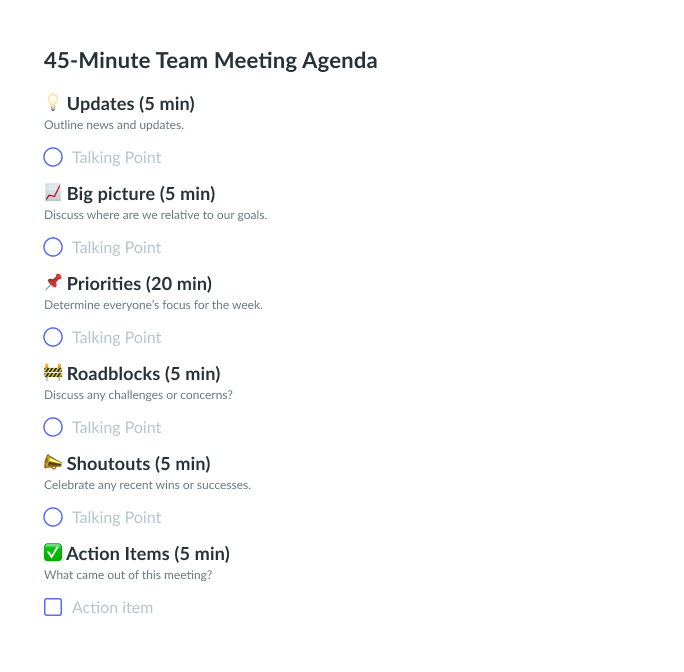
3 One-on-one meetings
We are big fans of one-on-ones here at Fellow. (We even wrote the definitive guide to one-on-one meetings)!
One-on-one meetings are private discussions between a manager and an individual team member. These meetings provide a dedicated space for personalized feedback, goal-setting, and addressing specific concerns or challenges. They strengthen the manager-employee relationship, enhance performance, and promote professional development. Effective one-on-one meetings involve active listening, mutual respect, and a focus on individual growth and support.
Curious to know what the world’s best managers ask during their one-on-ones and manager meetings? Here are 200 one-on-one meeting questions and a one-on-one meeting template to get you inspired!
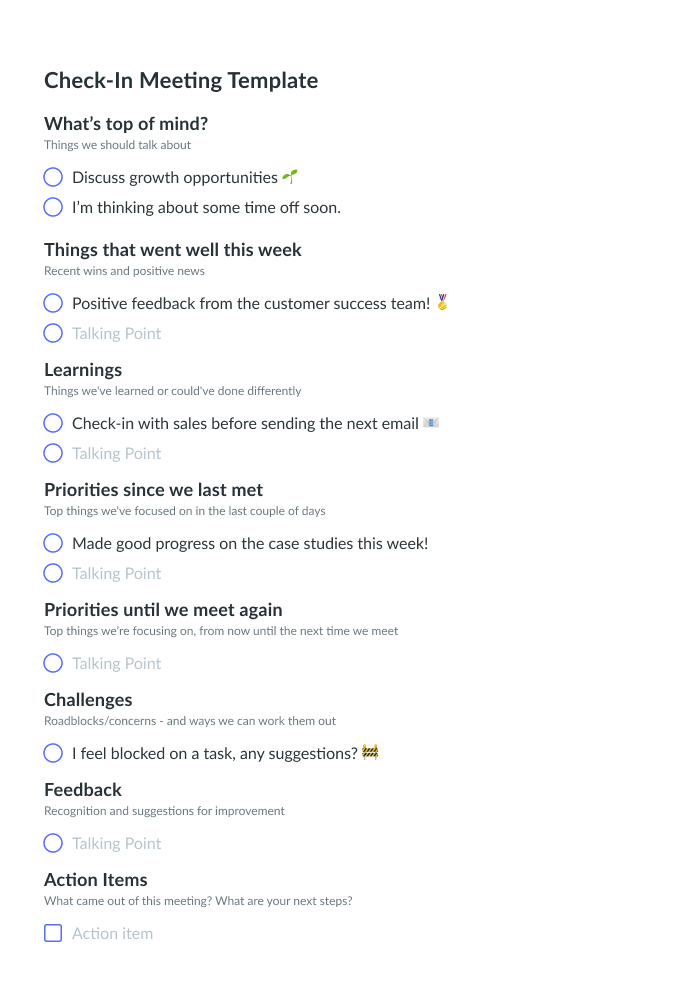
4 Decision-making meetings
If you’re ever feeling stuck on a project or major decision, consider scheduling a decision-making meeting.
Decision-making meetings occur when a specific agreement needs to be made. Often, discussions regarding important business decisions take place between larger groups and dedicate a specific meeting (or meetings) to arrive at a clear outcome. On the other hand, smaller-scale decisions might be made between fewer individuals and take place in status update meetings. During a decision making meeting, it is important to document the decisions made as action items.
After brainstorming, information gathering, evaluating options and ranking preferences, your group is sure to come to a final decision that the whole group feels comfortable with, even if it means a slight compromise once in a while. These meetings are highly interactive and everyone should be engaged so that they can contribute their perspectives to feel satisfied with a successful meeting.
5 Problem-solving meetings
Problem-solving meetings tend to have a specific goal in mind, which is remedying a current problem. To begin a problem-solving meeting, it is important that you identify the problem that needs to be addressed with your team. Consider all of the relevant information and then define the solutions requirements and restraints before you begin to brainstorm.
Where problem-solving meetings tend to occur after a threat or issue has surfaced, they can also be used in a preventative measure of issues that you may think are bound to arise as the project evolves. Problem-solving meetings could be needed in “emergency” situations as well, where a solution needs to be identified as quickly as possible to diffuse an already erupting situation. In an emergency case, be as quick and to the point as possible – you don’t have time to spare!
6 Brainstorming meetings
Brainstorming or Innovation meetings are a chance to encourage and cultivate creativity in your team by encouraging participants to build off of one another’s ideas. To begin, identify what you want to focus on, whether it is a big-picture situation or if you are looking to innovate a specific area of the business, a current process or operation. Include your entire team for these kinds of meetings, and make sure that you place a prominent importance on them!
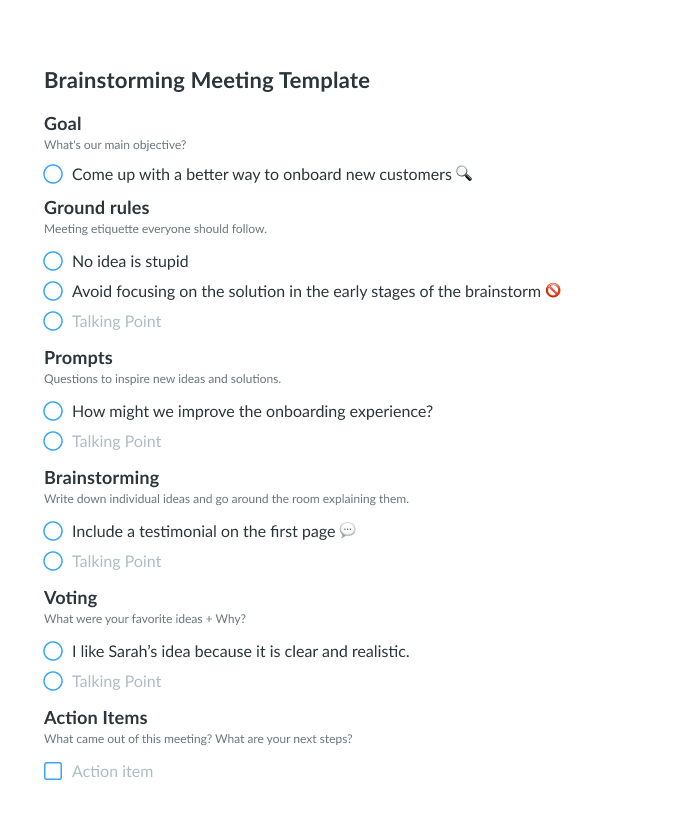
7 Project kickoff meetings
Project kickoff meetings mark the initiation of a new project, bringing together key stakeholders to establish project objectives, deliverables, timelines, and roles. These meetings set the tone, clarify expectations, and align the team’s vision and strategies. They promote collaboration, address any initial concerns, and ensure everyone understands their responsibilities. Effective kickoff meetings foster enthusiasm, build momentum, and lay a solid foundation for project success.

8 Feedback and retrospective meetings
One of the most important things you can do if you want to promote a growth mindset in your team is hosting a retrospective meeting after a project is finished.
Fostering a safe environment that is open and non-judgemental is essential to the success of this meeting so that the entire team feels comfortable sharing their feedback on the project.
Here are some items you can include in your project retrospective meeting agenda:
- Project overview: review the project timeline and major events.
- Learnings: share something you’ve learned while completing this project.
- What worked: acknowledge your teammates for the success of the project.
- Opportunities: find where improvements can be made for the next project.
9 Team-building meetings
Team- building meetings are meant to encourage relationship- building between team members to create more personal relationships. This type of rendez-vous is not necessarily in a meeting room (although it can be!) but can be a corporate event or outing to make it feel more casual and relaxed. This category of meeting can include meetings such as an all-hands meeting, a project kick-off meeting, team-building exercises or events.
Moreover, these meetings do not need to be confined to your team only. Team- building meetings are a great opportunity to get a department or entire organization in the same place to get to know who you are working with, building loyalty and engagement. Making your employees feel a part of the bigger picture and recognizing their accomplishments is going to motivate them to continue performing and will also promote satisfaction in their roles.
7 tips to make the best use of your meeting time
1 Set clear goals
Utilize a meeting agenda template tailored to your meeting’s purpose for clear goal-setting and focus. Stick to the agenda to avoid distractions and achieve meeting objectives efficiently. Send a checklist beforehand for required preparation, ensuring all attendees are ready to contribute comfortably.
2 Build an agenda in advance
Tailor your meeting agenda to the specific type of business meeting you’re conducting to ensure its success. The agenda keeps discussions focused and ensures punctuality with allocated time slots for each section. Send it in advance to allow time for preparation and to solicit suggestions beforehand.
3 Send invites ahead of time
Send meeting invites well in advance, not just agendas, respecting everyone’s time and demonstrating organization. For recurring meetings, establish a consistent time slot that suits everyone. Avoid canceling meetings whenever possible, prioritizing them and adjusting schedules accordingly to ensure productivity and commitment.
4 Leave space for questions
Make sure that you are always leaving a little bit of wiggle room before or after your meeting for your team to bring forward any comments, questions, concerns or suggestions. Setting up this space where your group feels comfortable approaching you is important in building trust and loyalty with your employees. It’s important for your group to know that you welcome and value their thoughts. Offer to set up separate, one-on-one meetings for individuals who require a little more time and attention privately.
5 Run through a post-meeting recap
It’s important to run through a post meeting recap so that you can assess the outcome of the meeting and whether it achieved the desired outcome. Next, you can identify what would have made it more successful, documenting and implementing these points for next time. A recap of the meeting will boost the retention of information as well as clear up any miscommunications. Having someone dedicated to writing effective meeting minutes is essential, seeing as it is extremely easy to forget specific details of the meeting.
6 Define actionable items
Define the actionable items, their deadlines as well as the person assigned to complete them. If more than one person has been assigned to an item, it is important that these individuals know that they need to touch-base and work together to get things done. If you have identified any possible hiccups, be sure to include them into the document. Ensure that this file is readily accessible and updated regularly by the individuals who are in charge of their specific actions, marking the progress or completion in real- time.

7 Ask for feedback
As always, it is super important that you are asking your team for feedback as well as giving feedback to the employees who have participated in successful meetings. To create a culture of continuous improvement, consider using a real-time feedback software such as Fellow.
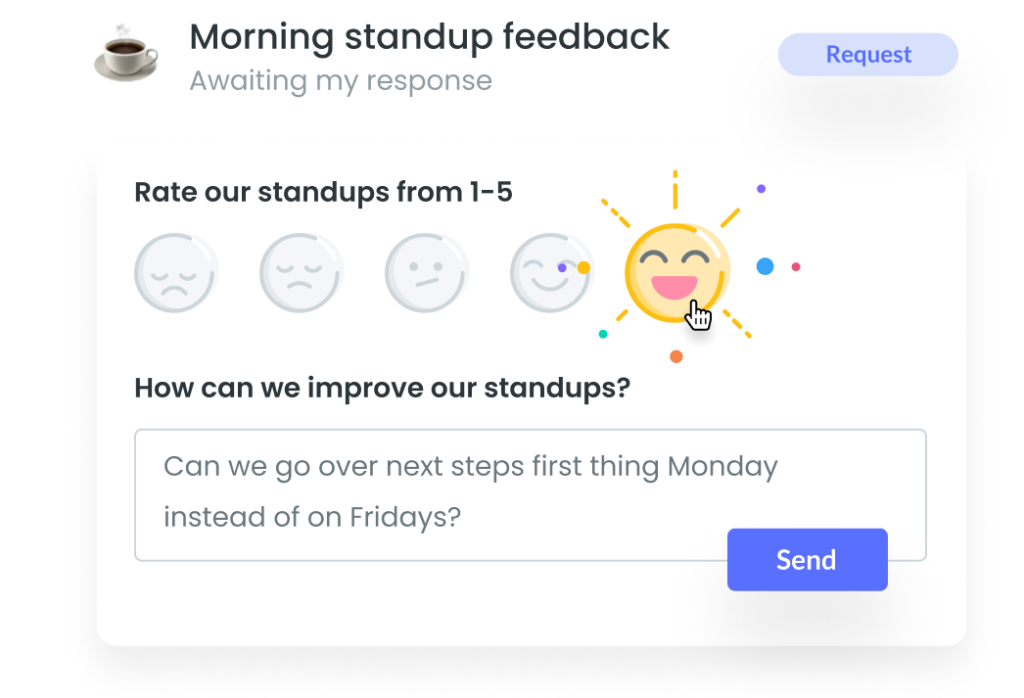
You can also power your interactions with our feedback templates. Check out our recent blog post on how great managers give and receive feedback for some further reading and best practices.
Parting advice
There are tons of different types of team meetings. It is important to tailor the structure, content and delivery mode of each meeting unique to the goal it is trying to achieve. Refer back to this guide for comprehensive descriptions of the 9 types of meetings you need to know as well as tips for making the best use of your meeting time. Successful meetings don’t need to be complicated but simply, well thought through.


![12 Common Types of Meetings [+ Free Agenda]](https://fellow.app/wp-content/uploads/2022/08/Types-of-Meetings-2.jpg)

![Status Meeting: 9 Best Practices For an Effective Meeting [+ Free Templates]](https://fellow.app/wp-content/uploads/2022/05/Status-Meetings-2.jpg)





